Flying high under the radar
Air traffic controllers’ work behind the scenes is essential, but goes largely unnoticed
Advertisement
Read this article for free:
or
Already have an account? Log in here »
To continue reading, please subscribe:
Monthly Digital Subscription
$1 per week for 24 weeks*
- Enjoy unlimited reading on winnipegfreepress.com
- Read the E-Edition, our digital replica newspaper
- Access News Break, our award-winning app
- Play interactive puzzles
*Billed as $4.00 plus GST every four weeks. After 24 weeks, price increases to the regular rate of $19.00 plus GST every four weeks. Offer available to new and qualified returning subscribers only. Cancel any time.
Monthly Digital Subscription
$4.75/week*
- Enjoy unlimited reading on winnipegfreepress.com
- Read the E-Edition, our digital replica newspaper
- Access News Break, our award-winning app
- Play interactive puzzles
*Billed as $19 plus GST every four weeks. Cancel any time.
To continue reading, please subscribe:
Add Winnipeg Free Press access to your Brandon Sun subscription for only
$1 for the first 4 weeks*
*$1 will be added to your next bill. After your 4 weeks access is complete your rate will increase by $0.00 a X percent off the regular rate.
Read unlimited articles for free today:
or
Already have an account? Log in here »
Hey there, time traveller!
This article was published 11/12/2015 (3585 days ago), so information in it may no longer be current.
There is a nondescript, tightly secured building on Moray Street, just across from an auto body shop, that’s rarely seen by civilian eyes.
Inside, past the double security gates, is a cavernous 7,000-square-foot room filled with 26 work stations that each contain up to eight computer screens.
It’s called the operations room, where dozens of men and women are monitoring every single airplane in the sky from northwestern Ontario north to Hudson’s Bay and most of Saskatchewan — as many as 1,500 flights during a normal weekday.
It’s almost eerily quiet, and designed to be that way.
“Controlling airplanes requires 100 per cent of your attention 100 per cent of the time,” said Marie-Pier Berman, manager of operational training for Nav Canada’s Winnipeg region.
“It’s a distraction-free environment. They’re very focused.”
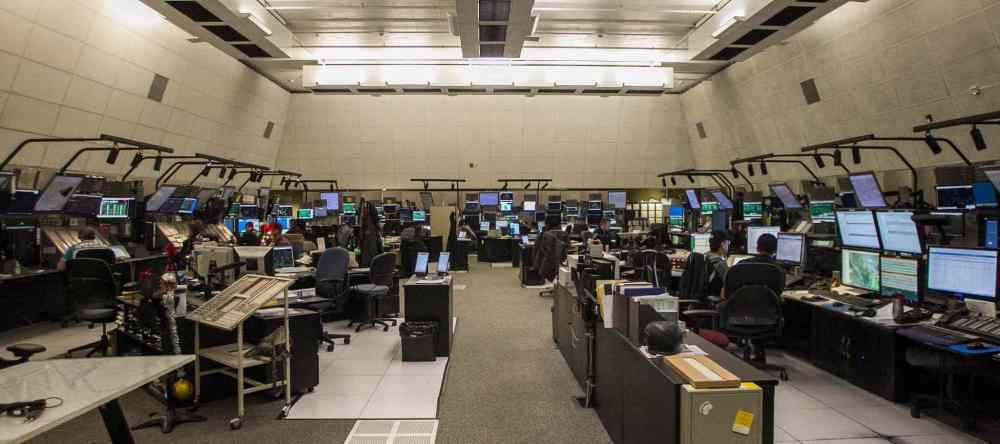
So how do you monitor thousands of planes simultaneously over Canadian airspace; where they’re headed, their altitude, their speed, and land them all safely?
Well, for starters, it takes 4,600 employees working in seven flight information regions linked by a massive database that logs and monitors each flight from coast-to-coast.
Each regional centre has an operations room that monitors the big picture. Each has a traffic control tower where controllers focus on landings and departures only.
It’s a complex, team-oriented system linked by land-based radar data fed into 2½-metre high servers (which fill a 5,000-sq.-ft. room in the Moray Street building alone) and distributed across the seven regions.
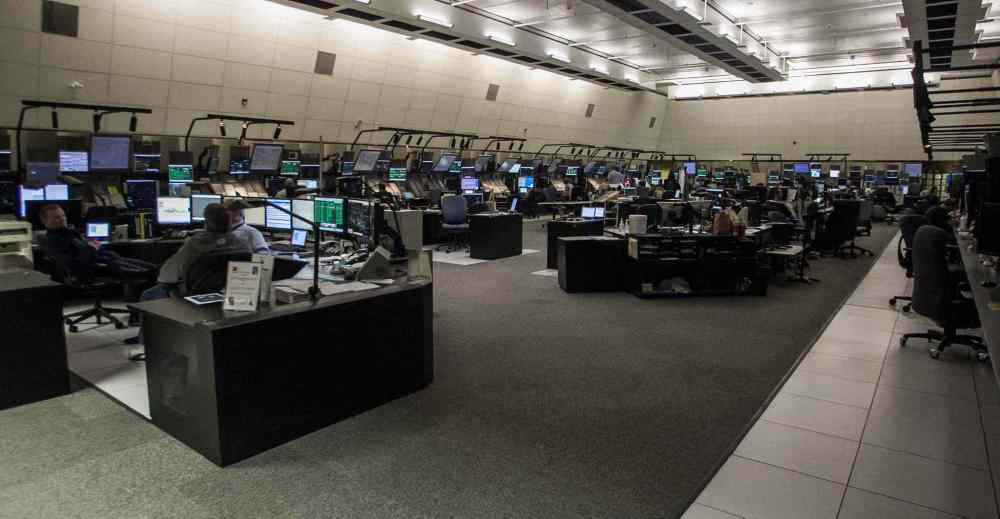
In the Winnipeg headquarters, for example, each controller is responsible for a specified patch of real estate, depending on traffic.
One group handles traffic above 29,000 feet, another group monitors traffic below that threshold. Approximately 150 to 160 controllers work in Winnipeg around the clock, 365 days a year.
“We’re one of those careers nobody knows about,” Berman noted. “They (travellers) see the pilots. They see the flight attendants. They don’t see this.”
And what the customer would see, like most professions, is not what is often portrayed in movies or television, where dramatic tension typically requires a life-or-death, against-all-odds landing of a plane that barely ekes to a stop before the end of the runway.
“As you can see, it’s not like Hollywood,” said Jonathan Bagg, Nav Canada’s public affairs manager.
“It’s a quiet, professional environment.”
Bagg acknowledged, however, the occupation “if you pardon the pun, is kind of flying under the radar.”
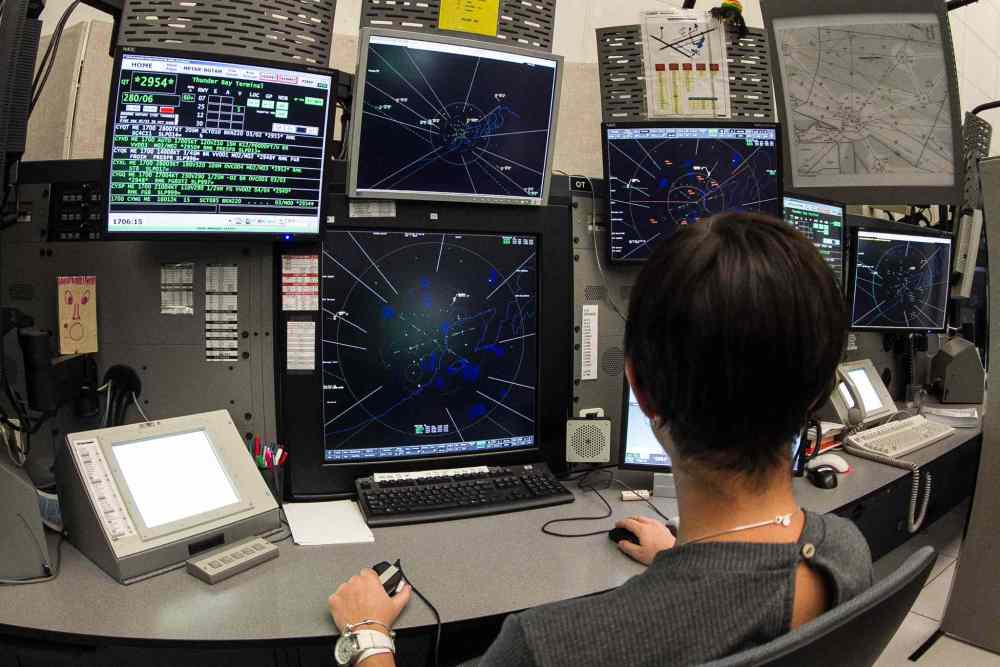
Nav Canada invited the Free Press for a behind-the-scenes glimpse at its operations for a specific reason: it is looking for recruits.
During the next five years, the company — a private firm (since 1996) that controls 100 per cent of Canadian civil airspace under Transport Canada regulations — hopes to hire from 120 to 140 employees for the Winnipeg region, which includes 11 flight services centres and five control towers.
The jobs pay well, from $90,000 to $110,000 for the operations centre and from $70,000 to $100,000 for the towers.
On an average 8½-hour shift, controllers work 45 minutes on and 30 minutes off (depending on workload), which is required given the concentration needed while at their stations.
During breaks, there is a quiet room for them to shut their eyes or lounge on a recliner and watch a big-screen TV in the cafeteria, which is operated by Stella’s restaurant. There’s also a gym in the building.
Said Bagg: “There’s an expectation that you need to come in ready to go, well-rested and in good shape.”
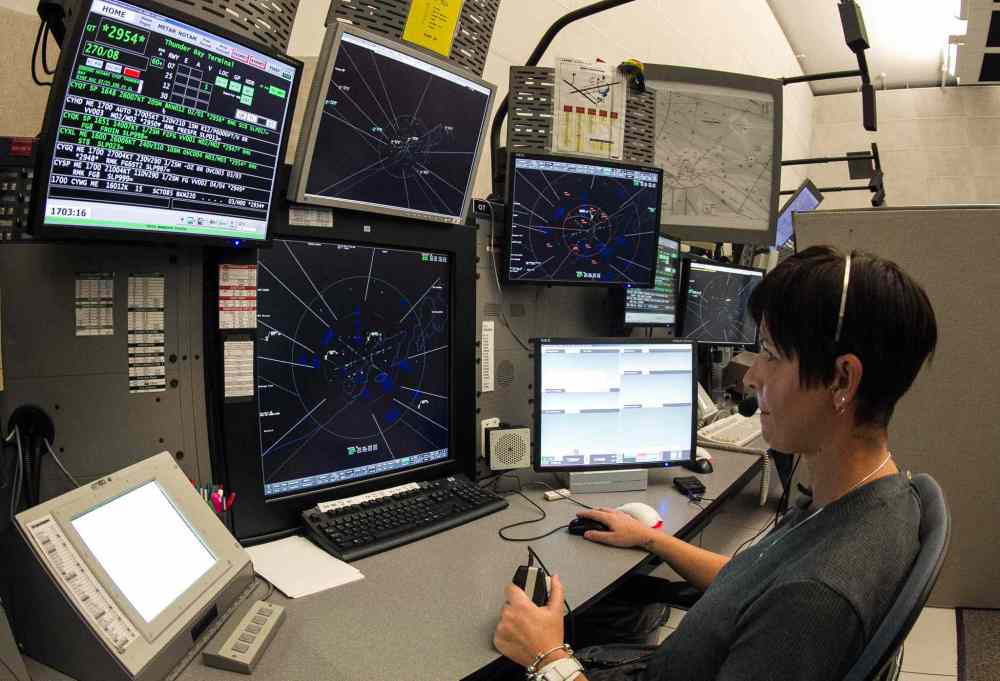
Since there is no secondary school course to be an air traffic controller, Nav Canada trains its own employees.
It’s a two-phase program that consists of one year in a classroom and another one-plus years of on-the-job training.
During the classroom portion, which includes work on simulators at the centre, trainees pay between $1,500 and $3,500 in tuition fees. The on-the-job training is a salaried position.
Applicants need only be Canadian citizens over the age of 18 who have a high school diploma.
However, for every 10 who apply for the program, only one meets the criteria, which is based largely on aptitude.
One qualification repeated by Berman — a former controller and supervisor — is confidence.
Another is spatial orientation, the ability to essentially think in three dimensions while looking at a two-dimensional image on screen.
“It’s a skill that’s innate,” she said, not unlike hand-to-eye co-ordination. It can’t be taught.
Indeed, the training process is sometimes more demanding than the job, given the simulated challenges students are required to overcome.
“The selection process is very competitive,” Bagg noted.
Once accepted, the students are trained not just for specific jobs (air traffic or flight services, for example), but for specific regions.
The air traffic control simulator at the Winnipeg headquarters is the replica of the view from the tower at the Richardson International Airport.
“You’re training people from the region for the region,” Bagg said.
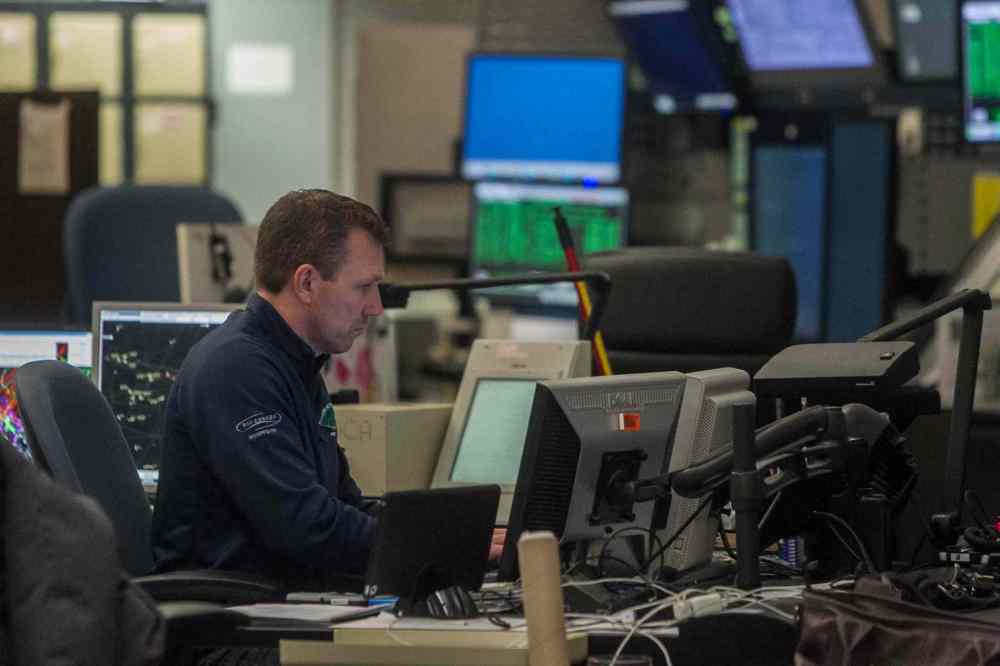
Some 15 years ago, Jennifer Tycholis, of Stonewall, left her job in the banking industry to become an air traffic controller.
“I was bored,” she explained.
Now 40, Tycholis is a veteran at the operations centre and said the biggest misconception of the job is that each shift is a high-wire act akin to juggling chainsaws.
“When I tell people what I do, they always say, ‘It must be so stressful,’ ” Tycholis said.
“I find that difficult to answer because I don’t feel stress. I find it challenging at times, but… you go home at the end of the day and you get a lot of satisfaction. That’s what makes you want to come back the next day.”
Mike Epp, 33, was looking for a team-oriented career after finishing university, where he played hockey. He looked at firefighting and police work before noticing air traffic controller was also on the list of potential jobs he was interested in, so he signed up and was certified in 2009.
Epp said it’s more stressful coaching a children’s minor hockey team. The work is more about solving problems; looking at the safest, most expedient method to guide and land the little dots on his screen given many available options.
However, there are services available to Epp and Tycholis that are not standard in most jobs — not just the availability of on-site massage therapy.
And for more serious incidents — such as divorce or death in the family, for example — there’s also a critical-incident stress-management team made up of peers available just to talk.
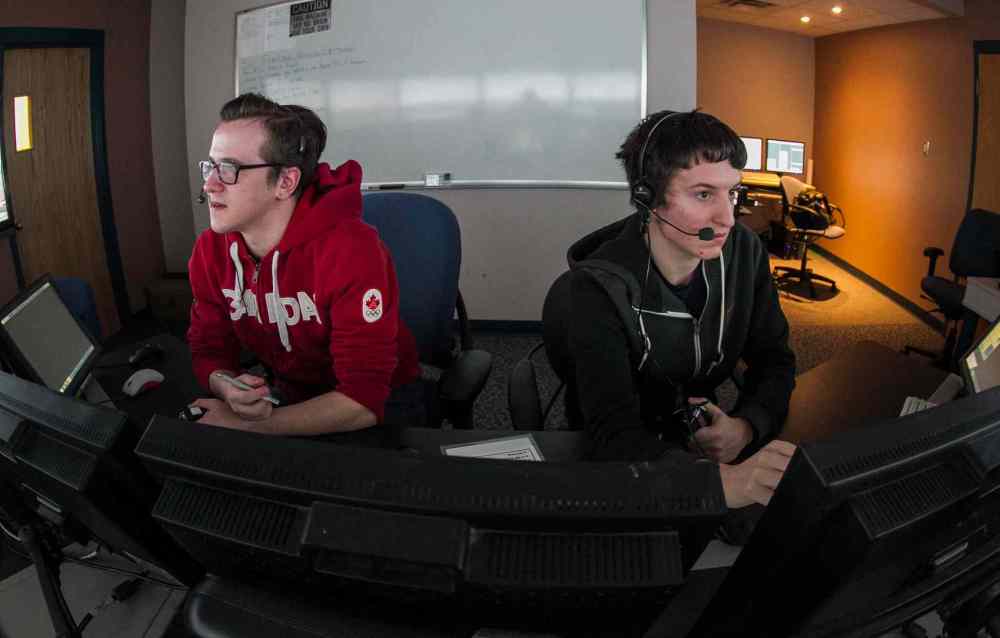
Why the stress on stress? Because when emergencies arise, the room for occupational error is negligible.
Take 9/11, perhaps the most tension-filled day in aviation history in North America.
Within minutes, Nav Canada controllers were required to immediately land 1,500 aircraft after a government-ordered shutdown of Canadian airspace.
Another 238 aircraft destined for Europe or the United States were also landed safely on Canadian soil, including 15 flights that were diverted to Winnipeg.
Although the terrorist attacks in 2001 resulted in increased security at all Nav Canada operations, the basic fundamentals involving the “separation of aircraft” — the industry term — did not change.
“In terms of how it changed the job, it didn’t. That’s fundamentally what happens here,” Epp said.
On a routine day, the job requires mostly logistics.
“It’s like putting a puzzle together,” Tycholis said.
“We’re each a piece of the puzzle,” Epp added. “And that puzzle is going to be put together by the end of the day.”
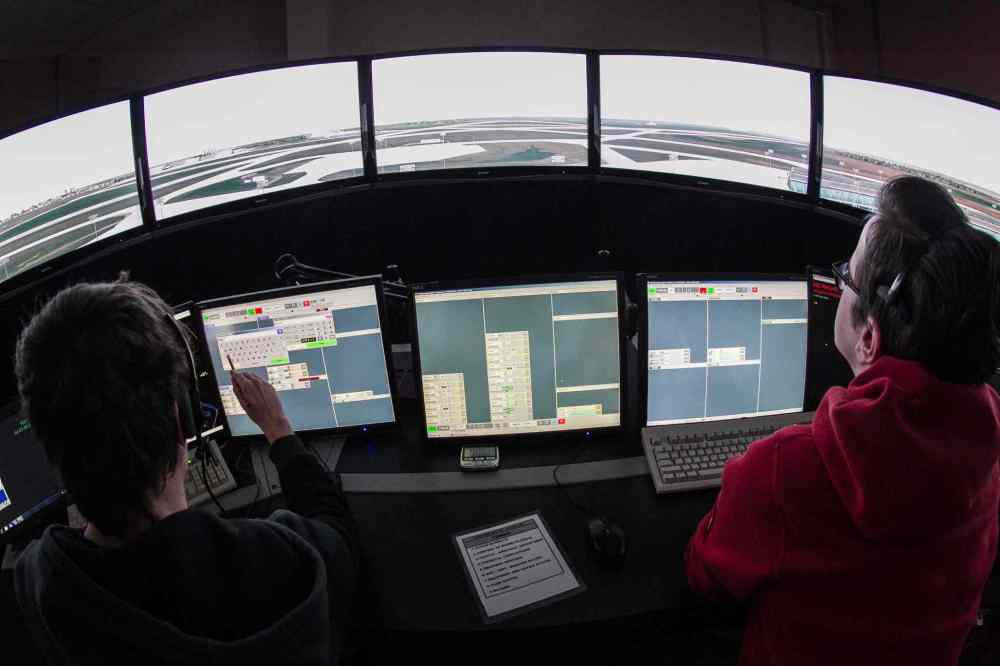
Most controllers and students come from diverse backgrounds, usually with previous experience in the workforce or post-secondary education.Epp is currently mentoring an on-the-job trainee who has a degree in geology. Another student working in the simulation room was a manager at a major hardware retailer.
Ian Reid, who instructs students specializing in tower training, said the simulator runs on voice recognition and can create any situation in any weather conditions. A simulation can include anything from water bombers to snowplows.
Reid noted the new generation of students has a “different skill set,” where interfacing with technology has been ingrained from youth. But Reid said human interaction remains a critical component of the job.
“Everybody works together,” he explained. “I don’t want a high-strung singles tennis player, I want a good doubles partner.”
Technological evolution is also a constant in the operations room. More and more information that was once written by hand is computerized to allow for easier transmission. Instead of talking to pilots on the phone, an increasing amount of the communication between ground and plane is done by text messaging: just like real life.
Soon, Nav Canada will be part of a system in which radar data will be collected by satellite surveillance, instead of ground-based instillations, vastly improving the ability to monitor flights over large bodies of water or remote Arctic regions.
“To have all of that information at a controller’s fingertips is very powerful,” Bagg said.
randy.turner@freepress.mb.ca

Randy Turner
Reporter
Randy Turner spent much of his journalistic career on the road. A lot of roads. Dirt roads, snow-packed roads, U.S. interstates and foreign highways. In other words, he got a lot of kilometres on the odometer, if you know what we mean.
Our newsroom depends on a growing audience of readers to power our journalism. If you are not a paid reader, please consider becoming a subscriber.
Our newsroom depends on its audience of readers to power our journalism. Thank you for your support.
History
Updated on Friday, December 11, 2015 5:55 PM CST: Updates images.

